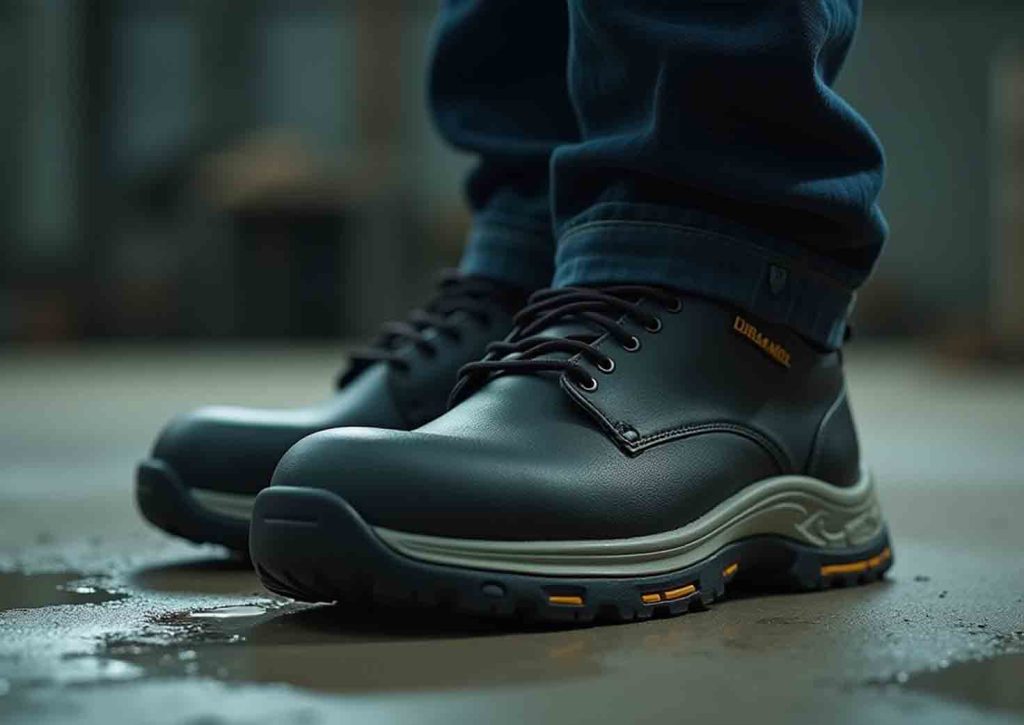When choosing the right safety footwear, materials matter. Whether you work in construction, manufacturing, or are simply looking for durable safety footwear for electricians or other demanding jobs, selecting the right type of shoe can make all the difference. Two of the most common materials used in safety shoes are PU (Polyurethane) and PVC (Polyvinyl Chloride). But how do they differ, and which one is better for your needs? Let’s dive in and compare these two materials to help you make an informed decision.
Understanding PU Safety Shoes
PU (Polyurethane) safety shoes are widely known for their comfort, flexibility, and durability. PU is a lightweight material often used in the sole of the shoe, making it a popular choice in industries where workers are on their feet all day.
Key Benefits of PU Safety Shoes:
- Lightweight: PU soles are significantly lighter compared to PVC, reducing fatigue, especially in jobs that require prolonged standing or walking.
- Comfortable: Polyurethane has excellent cushioning properties, offering superior comfort throughout the day.
- Durability: PU shoes are known for their long-lasting wear, as the material resists abrasion and wear better than many other types.
- Flexibility: PU is highly flexible, making it easier for users to move without restriction.
- Shock Absorption: PU soles offer better shock absorption, reducing the impact on joints and preventing injury, which is particularly important for people working in high-impact environments.
Ideal Applications for PU Safety Shoes:
- Manufacturing: Long hours on hard surfaces make PU shoes an excellent option.
- Construction: The durability and flexibility help reduce fatigue.
- Electrical Work: Lightweight and comfort make these shoes a go-to for electricians.
PU safety shoes are often recommended for anyone needing durable safety footwear for tasks that require agility and long wear.
Understanding PVC Safety Shoes
On the other hand, PVC (Polyvinyl Chloride) safety shoes are known for their waterproofing and affordability. PVC is typically used in industries that require heavy-duty footwear with excellent chemical and abrasion resistance.
Key Benefits of PVC Safety Shoes:
- Waterproof: PVC shoes provide excellent protection against water, oils, and chemicals, making them perfect for wet or hazardous environments.
- Affordable: PVC shoes are generally more cost-effective compared to PU shoes, making them an attractive option for industries with tight budgets.
- Resistant to Chemicals: PVC is highly resistant to many chemicals, acids, and bases, which makes it ideal for industries like food processing or chemical manufacturing.
- Durability in Wet Environments: PVC maintains its structure and durability even when exposed to harsh environments, such as muddy or wet conditions.
Ideal Applications for PVC Safety Shoes:
- Food Processing: The waterproof and chemical-resistant nature makes PVC ideal for food processing plants.
- Chemical Industry: Protection from chemical spills and hazardous substances.
- Agriculture: Wet and muddy conditions require the waterproofing properties of PVC.
However, PVC shoes are heavier than PU shoes, which may cause discomfort over extended periods, especially if you are on your feet for most of the day.
Comparing PU and PVC: Key Differences
Here’s a breakdown of the primary differences between PU and PVC safety shoes:
| Feature | PU Safety Shoes | PVC Safety Shoes |
|---|---|---|
| Weight | Lightweight and flexible | Heavier in comparison |
| Comfort | Superior cushioning and shock absorption | Less comfortable for long-term wear |
| Waterproofing | Not fully waterproof | Highly waterproof |
| Chemical Resistance | Moderate resistance | Excellent resistance to chemicals and oils |
| Durability | Long-lasting in dry, abrasive environments | Best for wet or chemical-heavy environments |
| Price | Higher cost | More affordable |
Which Is Better for Your Industry?
The best choice between PU and PVC safety shoes depends largely on your specific working conditions. Here’s a breakdown based on different industries and requirements:
- For Electricians and Construction Workers: PU safety shoes are often the better option. They offer superior comfort, flexibility, and shock absorption, making them ideal for professionals who are on their feet for long periods. Safety shoes for electricians benefit from PU’s lightweight nature and comfort, especially in indoor environments.
- For Wet or Chemical-Prone Environments: PVC safety shoes are the way to go. Their resistance to water and chemicals makes them ideal for those working in agriculture, food processing, or chemical industries. If you’re dealing with fluids or hazardous materials daily, PVC shoes will provide the protection you need.
- For Budget-Conscious Choices: If you need an affordable option and are willing to trade off some comfort for price, PVC shoes might be more cost-effective. Industries that require bulk purchases or replacement of footwear more frequently may find PVC a better fit for their budget.
Maintenance and Care Tips
Regardless of whether you choose PU or PVC safety shoes, proper maintenance will ensure they last longer and perform better. Here are some tips:
- Keep Them Clean: Regularly clean your shoes to remove dirt, chemicals, or other substances that may degrade the material over time.
- Check for Wear and Tear: Inspect your shoes for cracks or worn-out soles, especially if you’re working in environments with heavy use.
- Store Properly: Avoid storing your safety shoes in extreme heat or cold, as this can damage both PU and PVC materials.
Final Thoughts
Both PU and PVC safety shoes offer unique advantages depending on your job’s needs. PU safety shoes excel in comfort, flexibility, and durability, making them perfect for jobs requiring long hours on your feet. On the other hand, PVC safety shoes are the go-to choice for wet or chemically hazardous environments due to their waterproof and chemical-resistant properties.
By weighing the specific demands of your industry, you can make the right choice that balances comfort, protection, and cost. Always consider the working conditions and specific hazards you’ll encounter to select the safety footwear that best suits your needs.



